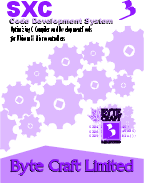- | Home |
- Company |
- Contact |
- News |
- S/ware Eng |
- Standards |
- Academic Support |
- Documents |

- | Requirements |
- Compilers |
- Validation |
- RTOS |
- Analysis |
- Hardware |
- Software |
- Resources |
- Products |
Byte Craft Scenix SXC

SXC extends support for the Ubicom (Scenix) SX family of processors, including the new SX48 and SX52 parts.
The SXC Code Development System includes:
• an optimising C Cross-compiler.
• the BCLink linker.
• an Integrated Development Environment and editor.
• a built-in macro cross-assembler.
.
Memory Management
SXC includes enhanced memory management such as LOCAL and SPECIAL memory directives. The LOCAL address space directive allows the user to maximize the use of RAM, direct the placement of local variables, re-use RAM locations and pass multiple arguments to functions. The SPECIAL memory directive adds support for variables in all types of memory, external or internal.
Features In Detail
Other features of the SXC Code Development System include:
• Highly optimised generated code. Full versions generate ROMable code, demonstration versions generate listing files with assembly.
• part-specific header files describe the unique features of each target device.
• compiler configuration using #pragma directives.
• ports are declared and protected using the #pragma port series of directives
• the #pragma vector directive specifies the location and assigned name for interrupt sources.
• BCLIDE Windows IDE organizes access to project settings and facilitates quick project build.
• BClink Linker links object files and libraries compiled with sxc.exe
• object libraries can be included directly in C source files using Absolute Code Mode.
• named address spaces support the grouping of variables at specific memory locations.
• SPECIAL address space declares variables at special locations such as external devices or internal EPROM.
• LOCAL address space allows you to use local variables.
• extensions to the C language designed specifically for the embedded systems developer. Some extensions include bit-sized data types, binary constants, extended case statements, direct variable placement with the @ symbol, and support for processor-specific functions.
• interrupt handler support in C; makes context saving and restoring easy.
•data types include:
bit, bits
char, short, int, long
int8, int16 (unambiguous ints)
register-oriented types for direct access to processor registers when necessary
• selectable 8 or 16 bit int data type.
• packed bit fields in structs.
• include single and multiple lines of inline assembly within a C program with the #asm and #endasm directives
• extensive control over computer-generated initializations.
• generates source-level information required for emulators.
• targeted to the entire Ubicom/Scenix SX family (A/B CPUs)
